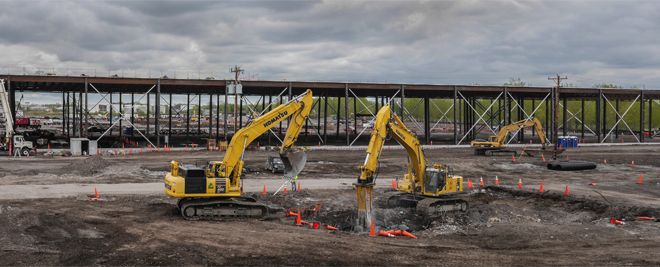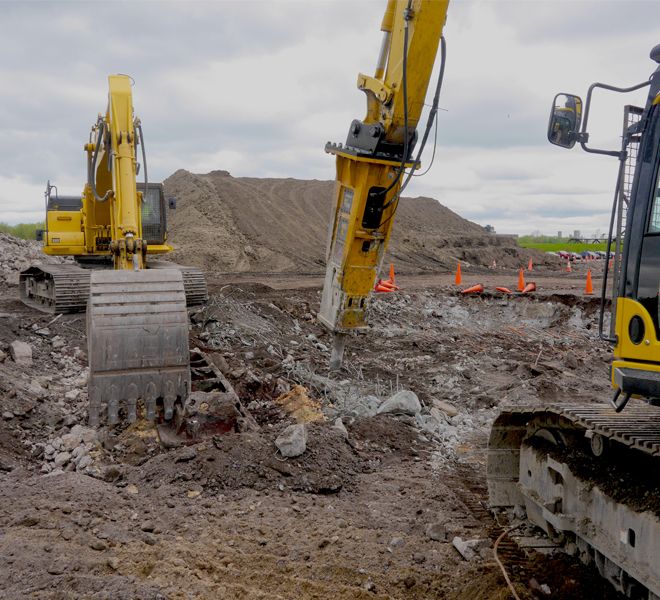From steel to solar power
Five Indeco breakers demolished the foundations of a former steel mill in Buffalo, New York in an area seeing construction of the largest solar panel production plant in the United States.
Upon completion, the new SolarCity solar panel manufacturing plant under construction in Buffalo, New York at the former industrial area of RiverBend will be the largest of its kind in the United States.
The project — one of the latest ventures of Elon Musk, founder of PayPal, SpaceX and Tesla — is of huge importance to Buffalo because it is closely tied to the city’s economic revival and is part of a broader plan called Buffalo Billion Dollar Initiative, which aims to attract high-tech companies to the RiverBend site. The new manufacturing hub, built on the grounds of an old steel mill, will occupy a total area of 29.4 hectares (61.5 acres) and annually produce next-generation solar panels in sufficient quantity to generate one gigawatt, establishing itself as the largest and most productive in the Western Hemisphere. At full production, the modern factory will employ over 2,000 workers in addition to 1,000 working in downstream activities. Site conversion and construction of the new industrial complex were assigned to LPCiminelli, a major contracting firm based in Buffalo that operates along the entire East Coast.
Underground challenges
Buffalo’s Republic Steel plant was in operation for over 70 years before being gradually dismantled in the 1970s until permanent shutdown in the 1980s. Later, all above-ground structures were demolished, leaving the area in brownfield conditions, that is, unready to be rezoned for new development. In 2007 the land was finally reclaimed but not cleared and prepared for construction. When the SolarCity project was drawn up, it turned out that the structures remaining below the 93,000+ sq. m surface of the new factory, and under the area designated for the utilities network, green spaces and parking lots, still had to be removed. The job involved the demolition of thick foundation slabs, supporting walls, and structures that were part steel, part cement and whose exact location and existence were uncertain. Using only excavators fitted with a bucket would clearly be insufficient; the job would require hydraulic breakers capable of demolishing structures even two or three meters below ground level. What initially seemed a necessary, yet secondary, step with respect to the construction of the new buildings, soon proved a major aspect of the job site. In May 2015, after a year of work, close to 25,000 cu m of concrete were demolished and hauled away. Added to that were around 3,000 tons of ferrous material (not only rebars, but also plant components, small rail cars, rails, blast furnace slag and other waste).
Indeco, the energy champion
As mentioned, right from the project design phase it was evident that the underground structures would have to be removed to permit construction of the new factory, but only once the works were begun did LPCiminelli technicians fully realize how much tougher this step was than expected. Because the steel mill had been active for decades, it had undergone changes and expansions through the years that were impossible to map with precision. Furthermore, preliminary recognition was made even more difficult by the fact that all above-ground structures had been demolished 30 years earlier and no clear or extensive visual references were left to allow precise identification of reinforced concrete elements, such as foundations, pavement and structural reinforcements to support the mill’s heavy plants and machinery. To perform demolition, LPCiminelli used five Indeco breakers, two HP 8000, two HP 13001 and an HP 16000. The breakers were used to a great extent, not only to demolish elements in reinforced concrete and structures where the new foundations were to be built, but also to excavate trenches for installation of the large utilities network. To say the project was a huge challenge is no exaggeration: over the course of six months the breakers operated intensively, demonstrating productivity and reliability despite difficult, if at times prohibitive, operating conditions. The job, moreover, involved removing very hard concrete, in some cases over 70 MPa (70 Kn/m² or 10.000 Psi) often cast with rebars with a size 36 or 34 diameter (12 and 10 U.S. size). In more than a few cases the concrete contained beams and other types of iron reinforcement that called for intense efforts for removal. To further complicate operations was the fact that Buffalo, one of the coldest cities in the United States, had been subjected to winter temperatures of -28.5°C (-20°F), freezing the ground and requiring the use of breakers to reach and discover the hidden concrete structures. When excavations have been completed, it is estimated that over 30,000 cu m of concrete will have been demolished and removed to prepare the site for the new SolarCity factory. Commenting on the project, Keegan Lachut, site manager for LPCiminelli had this to say: “The demolition was incredibly challenging, due both to the quantity of material we removed from the ground and because we really didn’t know what to expect as the job progressed. All Indeco breakers performed optimally, but in certain situations the one that delivered the best was undoubtedly the HP 16000. I don’t think I’ve ever seen a breaker giving that type of performance. In hindsight, if we had immediately understood how difficult the job would have been and the capabilities of the HP 16000, we would have rented five in place of the other models. As I said, the other breakers gave excellent performance, but given the hard task they needed more time to get the job done, especially in the most difficult situations.” Indeco breakers and most of the machines operated by the contractor were rented from Anderson Equipment, a major distributor of machinery and equipment on the East Coast with 21 branches from West Virginia to Maine. In addition to being an Indeco distributor, Anderson possesses a rental fleet of 70 breakers, from the small HP 350 to the HP 16000. At the Buffalo branch we met rental manager, Rod Dabolt, who remarked: “I think that Indeco offers some of the most reliable and productive breakers on the market today. Indeco is also the only manufacturer whose range includes true giants such as the HP 16000 and HP 25000 which, like the HP 16000 used at the RiverBend site, can really make a difference in the toughest working conditions. As rental fleet manager of this branch, I think that Indeco breakers offer the dual advantage of having a very wide range and being easily coupled to the Komatsu excavators that we distribute. Other winning features are definitely their longevity and modular construction that allows for easy maintenance.”









